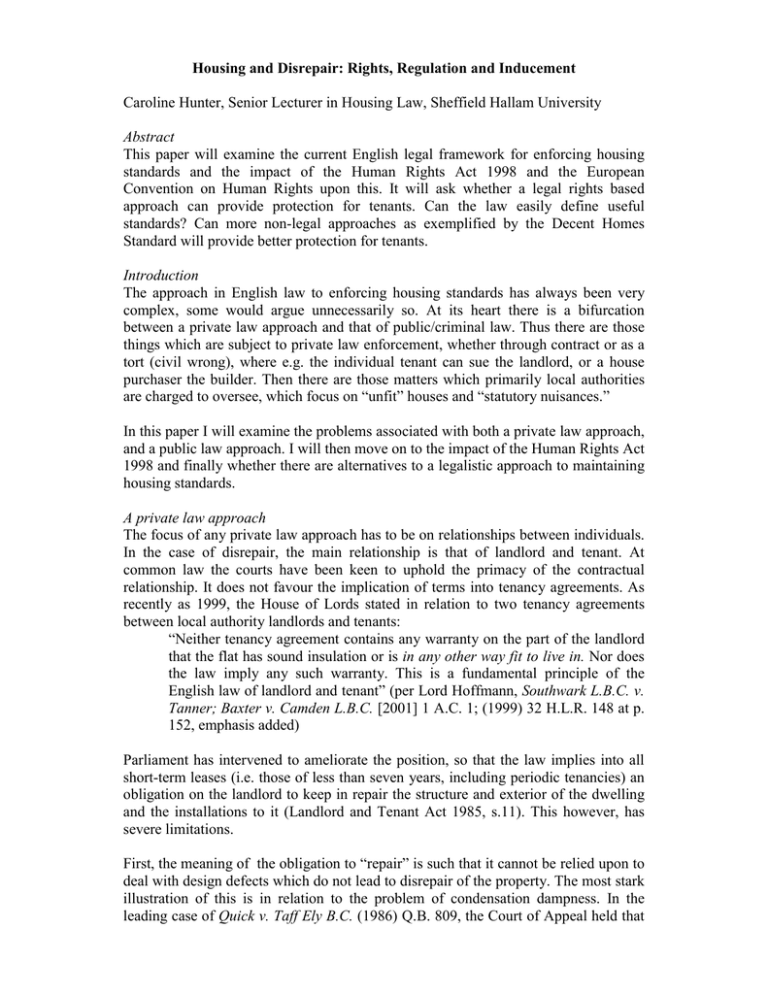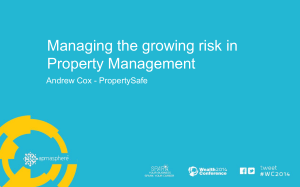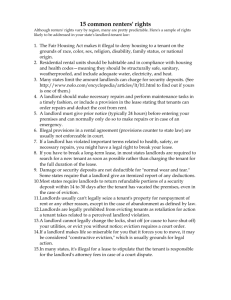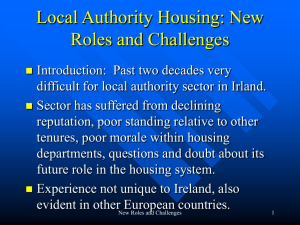Housing and Disrepair: Rights, Regulation and Inducement Abstract
advertisement

Housing and Disrepair: Rights, Regulation and Inducement Caroline Hunter, Senior Lecturer in Housing Law, Sheffield Hallam University Abstract This paper will examine the current English legal framework for enforcing housing standards and the impact of the Human Rights Act 1998 and the European Convention on Human Rights upon this. It will ask whether a legal rights based approach can provide protection for tenants. Can the law easily define useful standards? Can more non-legal approaches as exemplified by the Decent Homes Standard will provide better protection for tenants. Introduction The approach in English law to enforcing housing standards has always been very complex, some would argue unnecessarily so. At its heart there is a bifurcation between a private law approach and that of public/criminal law. Thus there are those things which are subject to private law enforcement, whether through contract or as a tort (civil wrong), where e.g. the individual tenant can sue the landlord, or a house purchaser the builder. Then there are those matters which primarily local authorities are charged to oversee, which focus on “unfit” houses and “statutory nuisances.” In this paper I will examine the problems associated with both a private law approach, and a public law approach. I will then move on to the impact of the Human Rights Act 1998 and finally whether there are alternatives to a legalistic approach to maintaining housing standards. A private law approach The focus of any private law approach has to be on relationships between individuals. In the case of disrepair, the main relationship is that of landlord and tenant. At common law the courts have been keen to uphold the primacy of the contractual relationship. It does not favour the implication of terms into tenancy agreements. As recently as 1999, the House of Lords stated in relation to two tenancy agreements between local authority landlords and tenants: “Neither tenancy agreement contains any warranty on the part of the landlord that the flat has sound insulation or is in any other way fit to live in. Nor does the law imply any such warranty. This is a fundamental principle of the English law of landlord and tenant” (per Lord Hoffmann, Southwark L.B.C. v. Tanner; Baxter v. Camden L.B.C. [2001] 1 A.C. 1; (1999) 32 H.L.R. 148 at p. 152, emphasis added) Parliament has intervened to ameliorate the position, so that the law implies into all short-term leases (i.e. those of less than seven years, including periodic tenancies) an obligation on the landlord to keep in repair the structure and exterior of the dwelling and the installations to it (Landlord and Tenant Act 1985, s.11). This however, has severe limitations. First, the meaning of the obligation to “repair” is such that it cannot be relied upon to deal with design defects which do not lead to disrepair of the property. The most stark illustration of this is in relation to the problem of condensation dampness. In the leading case of Quick v. Taff Ely B.C. (1986) Q.B. 809, the Court of Appeal held that there was no breach of s.11 where a property because of poor design was particularly prone to condensation dampness. Although a lack of adequate heating and metal window frames were to blame, there was no breach of section 11 as there was no disrepair to any part of the structure or exterior of the house. Lack of adequate amenities, be it heating or perhaps a bathroom, are simply not addressed by section 11. As Lord Hoffmann recognised in the Southwark case (above): “In many cases, of course, the tenant does not have the bargaining power to exact an express warranty as to the condition of the premises or the freedom of choice to reject the property which may not meet his needs. This is often the case with local authority housing. For this reason Parliament has in various way intervened to protect tenants from the bleak laissez-faire of the common law” (at p. 152-153). The Landlord and Tenant Act 1985, s. 8 deals expressly with lack of amenities and provides that it is an implied term of every letting to which it applies that the premises are fit for habitation. The problem is that the term has always been limited to tenancies at a low rent, and the figure for a low rent has not been updated for nearly 50 years. Thus it applies only to tenancies whose rents are not more than £80 per annum in London or £52 per annum elsewhere. The provision thus is of no use today. The Law Commission has proposed (Law Commission 1996) that a statutory warranty that a dwelling-house is fit for human habitation should be implied into any lease for less than seven years. The report has not been acted upon and no Parliamentary time has been found to bring forward the proposed legislation. While legal claims may be founded on other relationships, e.g. builder/purchaser, neighbours, it is the landlord and tenant one which founds the most common form of legal claim. Its limitation have been examined above. But two further issues must be considered is assessing the usefulness of private law rights in enforcing housing standards. First, there is the reliance that this puts on the aggrieved individual in taking action. There is a considerable body of evidence that much potential litigation simply does not happen (see Genn, 1999). For tenants in the private sector, who are almost all now on short-term leases with minimal security of tenure, there can be very little incentive to take legal action when it may simply result in a tenancy agreement not being renewed or possession sought. One study of social landlords (Pawlowski and Brown, 2002) found that while for the vast majority of landlords their housing stock suffered from condensation dampness, only 42% of landlords stated that their tenants resorted to legal action (whether private law or under the EPA 1990, discussed below). From another point of view landlords, particularly large scale social landlords, will argue that money spent on litigation diverts resources from proper planned maintenance and improvements (Morris, 1997). Those who litigate are not necessarily those in the greatest need of work to their home, or in the homes where money can most efficiently be spent. Secondly, because most legal action is based around the landlord and tenant relationship it does nothing to address issues of disrepair in the owner-occupied sector. Although in general owner-occupied housing is in better condition than that of the rented sector (EHCS, 1996), because of the size of the sector in England (approximately 70%) the largest amount of poor housing is owner-occupied. Private law rights can and do place responsibility for maintaining certain standards, but they can only do this where there is the necessary relationship in place to which legal responsibility can be attached. Furthermore the state has not generally intervened in those relationships to ensure anything beyond minimum standards. The legal powers of local authorities The powers of local authorities to deal with housing standards are spread through a variety of legislation. I intend here, for reasons of space and simplicity, to focus on two: unfitness under the Housing Act 1985 and statutory nuisance under the Environmental Protection Act 1990 (thus ignoring provisions in the Housing Act 1985 relating to houses in multiple occupation, dangerous buildings and those contained in the Building Act 1984). Provisions for dealing with unfitness have been in place for over a century. The definition of unfitness was amended in 1989. It deals with both lack of repair and lack of amenities (Housing Act 1985, s.604). Where a local authority decide that a property is unfit for human habitation they must then decide what is the “most satisfactory course of action” for the property. This may be serving a repairs notice, a closing or demolition order or a deferred action notice. Failure to comply with notices is generally a criminal offence. Thus an active local authority has a series of tools which can deal with housing conditions. The process is not, however, without its critics and a new standard, the Housing Health and Safety Rating System has been developed, and the government have said will replace the existing system. The criticisms of the existing system (Ormandy, 2002) include that the current standard does not deal with many conditions which may threaten the health and safety of users, e.g. fire safety, poor energy efficiency and radon gas. Furthermore some of the tests of unfitness require some qualitative professional judgment, e.g. whether dampness is prejudicial to health. The definition of unfitness also requires that the defects in the dwelling make it “not reasonably suitable for occupation”. This is a vague and difficult phrase to interpret, and can lead to variations in interpretation. I do not intend here to address the details of the new HHSRS system (that is done elsewhere in the conference), but what is interesting from a lawyers point of view is the encouragement the government has given to local authorities to start using it, notwithstanding that there has not yet been any legislative change. While it may be useful for local authorities to trial the new system, it is not clear what else can be achieved by this. The basis for decision making as to what action can be taken remains that within the statutory provisions, and accordingly some local authorities have taken the view that it should be ignored for the moment. One other problem with unfitness provisions, which have not been addressed by the proposed changes to the system is the decision in R. v Cardiff C.C., ex p. Cross (1982) 6 H.L.R. 1. In this case the Court of Appeal decided that a local authority cannot be compelled to apply enforcement provisions to themselves. The effect of this is that large swathes of housing, some of which is in a poor condition is not subject to these provisions. While the transfer of local authority housing stock to other landlords may ameliorate this position, there will remain a significant number of tenants who are outside the protection of the law. It is also true to say that given limitations of resources local authorities have tended to be reactive rather than proactive. Unsurprisingly this leads to a focus on complaints, again leading to less action in relation to owner-occupiers. Turning now to the Environmental Protection Act 1990. This legislation, which also has a long lineage dating from the nineteenth century, controls statutory nuisances. Thus it is not solely concerned with residential premises, although it has been used extensively to deal with such properties, principally in relation to the definition of statutory nuisance as “any premises in such a state as to be prejudicial to health or a nuisance” (EPA 1990, s. 79(1)). Within this definition importantly can be encompassed premises which suffer from condensation dampness. As with the Housing Act 1985, the main route for enforcement is by action by the local authority. As with unfitness this means that there can be no action taken by the local authority in relation to its own stock. Under the EPA, however, there is a mechanism for a “person aggrieved” by a statutory nuisance to take action in the magistrates’ court against the “person responsible” for the nuisance (EPA 1990, s.82). Two issues arise from the taking of action by individual tenants under the EPA. First is the regular defence that arises in such cases, that the “person responsible” for the statutory nuisance is not in fact the landlord, but the tenant. This is particularly true in condensation dampness cases. In the Pawlowski and Brown study (2002), social landlords reported that the tenant’s claim was successfully defended/resisted in 25% of cases. The second problem facing tenants who wish to take action is that of funding. Any action is in the form of a criminal prosecution and legal aid is not available for such cases. For many years this led to disputes about how far solicitors were taking on such work on an unlawful conditional basis. Since 1999, however, conditional fee arrangements have been lawful. Again this is an area of law where landlords have claimed inappropriate action by solicitors in drumming up claims which divert funds from appropriate works, although one study found that these were not on the whole borne out (DoE, 1996). Thus we see with the two main public law remedies difficulties of definition and of application, which limit their effectiveness. The impact of the Human Rights Act 1998 It was suggested that the Human Rights Act 1998 might have a significant impact in terms of housing rights, and possibly extending the law. The Act incorporates into English law the European Convention on Human Rights (ECHR). The most relevant article of the ECHR is article 8, which provides that “Everyone has the right to respect for his private and family life, his home…” Some decisions of the European Court of Human Rights have suggested that there could be a positive obligation imposed by article 8 to protect individuals from serious infringement of their respect to family and private life through environmental pollution, see e.g. Lopez Ostra v. Spain (1994) 20 EHHR 277 and Guerra v. Italy (1998) 26 EHRR 357. The impact of those cases on English law was considered in the case of Lee v. Leeds B.C.; Ratcliffe v. Sandwell B.C. [2002] EWCA Civ 06; [2002] H.L.R. 17, which typically for many disrepair cases in English law concerned the problems of condensation dampness. The Court of Appeal effectively refused to upset the balance of law which has been developed over the last hundred years or so. In refusing to overturn the decision in Quick v. Taff Ely (above) the Court stated that it was not necessary to re-interpret s.11 of the Landlord and Tenant Act because of the Human Rights Act 1998. The 1985 Act was not incompatible with ECHR rights. In so doing they pointed to the fact that local authority tenants were not left without a remedy in this situation since they could take action under the EPA 1990. Most pointedly in rejecting an argument that the Human Rights Act 1998 imposes an independent duty on local authorities by article 8, the court relied on observations by Lord Hoffmann in the case of Southwark L.B.C. v. Tanner, above, where he said that the courts needed “to show a proper sensitivity to the limits of permissible judicial creativity” in the field of social housing responsibilities; a field which is “so very much a matter for the allocation of resources in accordance with democratically determined priorities.” One commentator (Smith, 2002) has suggested that there is still some hope for tenants in the decision, since the Court of Appeal did leave open the question of whether there might be such extreme conditions that there could be a breach of article 8. This actually potentially leaves local authority tenants in a better position than others, since under the Human Rights Act 1988 the duty to comply and the correlative right to sue is only imposed on local authorities (HRA 1998, s. 6). On the whole the courts have been very unwilling to upset the balance of housing obligations developed by parliament in challenges based on the Human Rights Act, and the position in relation to disrepair seems no different. While there is still a potential challenge to a failure to act by a local authority in a very extreme case the fact that condensation dampness and mould growth were not severe enough to trigger any change to the law, suggests that it is unlikely to be of use to move forward housing standards generally. Improving standards through non-legal means Interestingly the government has sought to bring a real focus to improving the quality of housing in the social sector. It has not sought to do this, however, by amending legislation to implement the proposals of the Law Commission. It has, however, made the improvement of the housing stock, particularly that of social housing, a focul point of its housing programme. As part of the 2000 spending review the government set the target to make all social housing “decent” by 2010 and it was a strong theme on the Housing Green paper (DTLR, 2000). This commitment was extended in the 2002 spending review to cover to a certain extent: “By 2010, bring all social housing into decent condition with most of this improvement taking place in deprived areas, and increase the proportion of private housing in decent condition occupied by vulnerable groups.” “Decent homes” is not a legal concept, although it is in part defined through reference to the current legal standards. Thus a decent home meets the current minimum standard of fitness in the Housing Act 1985, s.604. In addition it has to be in a reasonable state of repair, which is defined into whether one key building component or two or more other building components are old and because of their condition need replacing or major repair. The dwelling must also have reasonably modern facilities and services i.e.: • A kitchen which is 20 years old or less • A kitchen with adequate space and layout • A bathroom which is 30 years old or less • An appropriately located bathroom and WC • Adequate noise insulation • Adequate size and layout of common entrance areas for blocks of flats. There is one further requirement that the dwelling provides a reasonable degree of thermal insulation (DTLR, 2002). It is interesting that in some areas of life the government seem keen to legislate endlessly to provide change, see e.g. in relation to anti-social behaviour. In relation to housing standards change is seen to be dependent on finance rather than law. The most recent review of implementation of the decent homes standard in social housing (PSA Plus Review, 2003) does not once mention the legal framework in which landlords operate. References are made to the need to put tenants at the heart of the process of providing decent homes, but is not suggested that this could be achieved by giving those tenants additional legal rights. It remains to be seen whether the sort of financial inducements which the government are offering (and some authorities are still suggesting they are far short of what is needed to bring their homes up to the decent standard) can bring about a bigger seachange, than a legislative duty. The problem will not doubt be in the amount of funding improving housing standards is expensive. The experience with grants for owner-occupiers, which when made mandatory simply led to authorities running out of money, and has ultimately led to the dismantling of the grant system and its replacement with a new system where they will virtually disappear, illustrates how governments will withdraw inducements if they prove too costly. Conclusions Private law rights give power to some individuals, but cannot improve properties. Public law/criminal remedies while they can improve properties, also have their limitations both in definition and also scope. The complexity of the law gives us different definitions which apply with different means of enforcement, some of which applies to some tenants and some to others, and which almost inevitably leaves owner-occupiers out of the equation. It has to be asked whether it can be an effective way of maintaining and improving standards. We have had over 100 years of legislation, which has seen constantly rising standards, but still given the wealth of the nation still a surprisingly large backlog of disrepair and poor standards. Notwithstanding this, we can perhaps illustrate the usefulness of legal targets by asking ourselves what will happen if the government fail to meet the decent homes targets that they have set themselves. If social landlords haven’t met the target will tenants be able to take direct action to get their home improved to meet it. The simple answer to this will be no. There may be inspection regimes, performance indicators and so on, all putting pressure on landlords but ultimately if the money is not adequate to achieve this, the tenants will be left high and dry or perhaps more pertinently one should say low and damp! References Department of Environment (1996) The Uses of Section 82 for the Environmental Protection Act 1990 Against Local Authorities and Housing Associations HMSO Department of Transport, Local Government and the Regions (2002) Quality and Choice: a decent home for all. English House Condition Survey (1996) Genn H (1999) Paths to Justice, Hart: Oxford Law Commission (1996) Landlord and Tenant: Responsibility for State and Condition of Property Law Commission No. 238 Morris (1997) "The price of rights" Inside Housing, October 17, p. 14 Office of the Deputy Prime Minister (2002) A Decent Home: the revised definition and guidance for implementation (available on ODPM website: www.housing.odpm.gov.uk/information/dhg/definition) Ormandy D. (2002) “Towards Safe and Healthy Housing” Journal of Housing Law, Issue 4, p. 50. Pawlowski M., and Brown J. (2002) “Condensation Dampness: Prejudicial to health?” Journal of Housing Law, Issue 2, p. 24 Smith R. (2002) “Unfit Public Housing and Human Rights: Lee v. Leeds City Council” Journal of Housing Law, Issue 4, p. 59.





